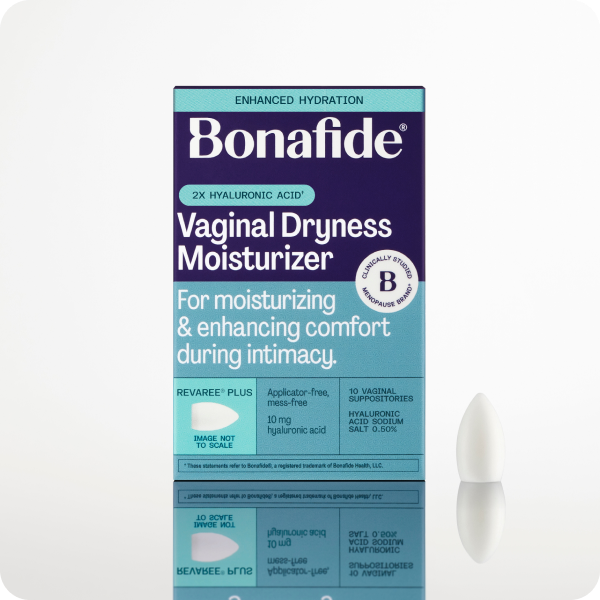You may already be familiar with the fact that the vagina has its own delicate pH level. It's normal for these levels to shift during perimenopause and menopause, however, disruptions to your typical pH can cause certain vaginal symptoms. So, how can you tell whether your vaginal pH is in balance?
A healthy vagina contains a mix of friendly and less-friendly bacteria which make up the vaginal microbiome. This microbiome helps the vagina maintain a naturally acidic pH, which can help to fight off infections and lowers the risk of irritation. But when this vaginal microbiome equilibrium gets thrown out of balance, so too can your pH levels.
Hear more from Bonafide Chief Medical Officer, Dr. Alyssa Dweck, about key things to know about vaginal pH, below:
Why Is My Vaginal pH Balance Off?
Shifts in vaginal pH during menopause occur naturally due to declines in the hormone estrogen. However, less estrogen can also make the vagina more susceptible to an imbalance of good bacteria such as lactobacillus, and bad bacteria like G. vaginalis as well as candida, a fungus.
If levels of bad bacteria become higher than normal, vaginal pH can rise and become less acidic.1 This decreased acidity can create an ideal environment for infections to thrive, including bacterial vaginosis (BV), yeast infections,2 or the sexually transmitted infection, trichomoniasis.3
How to Tell if Your pH Balance Is Off
Some are able to note an altered vaginal pH due to a change in vaginal discharge or scent. Others may not be able to tell whether vaginal pH balance has shifted. But if symptoms of unbalanced pH levels are associated with a vaginal infection,4 you’ll often notice the infection’s symptoms.5
- Bacterial vaginosis is often marked by a thin white or gray vaginal discharge. The discharge can have a strong, fishy odor that’s particularly noticeable after sex.
- Yeast infections cause the vagina to be red, itchy and irritated. Sometimes it can cause thick, white vaginal discharge that looks similar to cottage cheese, too.
- Trichomoniasis, which as mentioned is an STI, may not always cause symptoms. When it does, it's common to experience vaginal itching, burning, soreness, or pain while urinating. Foul-smelling, gray-green discharge can also occur.
Testing for Vaginal pH Imbalance
If you notice some potential vaginal pH imbalance symptoms and think that your vaginal pH might be off balance or just want to get a sense of what your normal pH is, an at-home testing kit can help. They come with a strip of pH paper that you can briefly press on the wall of your vagina as well as a pH color chart to base your results on. The paper will change color based on your current vaginal pH. You can match the color of the strip to the color on the chart to find out your vaginal pH number.6
At-home pH testing kits are easy to find in drugstores or online, and they're accurate. Just keep in mind that a higher- or lower-than-typical pH alone doesn't indicate that you have an infection. Always check with your healthcare provider if a vaginal pH test comes back abnormal, as they can help determine the best treatment option to get you back on track.
How to Manage Vaginal pH Imbalance
Again, a shift in vaginal pH doesn't automatically mean that you have an infection. Higher pH levels can make infections more likely to occur, though. So, if you're looking to manage your vaginal infection risk, taking steps to support a healthy vaginal pH may be helpful. Here are some ways to do that.
Avoid Douching and Use Unscented Care Products
Douching can disrupt the vagina's microbiome, leading to an increase in bad bacteria that can set the stage for an infection. In fact, it's best to let your vagina simply clean itself. When showering or bathing, you can wash your vulva (the external genital parts) with warm water or mild, fragrance-free soap.
Choose your products wisely, as scented products like soaps, laundry detergents or fabric softeners, tampons, sprays, pads, powders, or lubricants can also irritate the vagina and make an infection more likely.
Consider a Probiotic for Vaginal Health
Oral probiotics geared toward supporting vaginal health have been shown to boost the number of good bacteria in the vagina. This may help support a healthy pH level 7 .8 Experts are still learning about the most potent bacterial strains, dosages, and whether oral or vaginal probiotics are more effective.9 So, if you're thinking about using a probiotic to support your vaginal health, talk with your healthcare provider to decide on the right option for you.
Consider a Vaginal Moisturizer
Vaginal dryness, which can occur due to shifts in the hormone estrogen, can also contribute to changes to your vaginal pH. Not to mention it can cause associated symptoms like burning, itching, and painful sex. Regularly using a moisturizing vaginal insert can help keep vaginal tissues more hydrated, which may support healthier pH levels.10
When to Talk with Your Healthcare Provider
Let your healthcare provider know if you're experiencing symptoms or signs of a possible vaginal infection, or if you're experiencing vaginal dryness that's causing discomfort. Both of these issues can be related to a change in vaginal pH levels, but with the right care plan, they can be managed.
Resources
- https://www.ncbi.nlm.nih.gov/pmc/articles/PMC8618584/
- https://www.ncbi.nlm.nih.gov/pmc/articles/PMC5770522/
- https://www.ncbi.nlm.nih.gov/pmc/articles/PMC3955044/
- https://www.ncbi.nlm.nih.gov/pmc/articles/PMC3955044/
- https://medlineplus.gov/vaginitis.html
- https://www.fda.gov/medical-devices/home-use-tests/vaginal-ph
- https://journals.lww.com/jaapa/fulltext/2021/02000/probiotics_for_preventing_recurrent_bacterial.2.aspx
- https://www.ncbi.nlm.nih.gov/pmc/articles/PMC5770522/
- https://journals.lww.com/jaapa/fulltext/2021/02000/probiotics_for_preventing_recurrent_bacterial.2.aspx
- https://pubmed.ncbi.nlm.nih.gov/23574713/












Comments
Post commentI have been using Revaree for a year now. It has been essential in improving my dryness, itch & pain consistency. I don’t what I would do with out this product. I just started using The Plus & know I will feel a difference soon.
i had bv for several years using countless different vaginal antibiotic creams, suppositories, boric acid suppositories(at different strengths), etc. symptoms always cleared at the end of treatment but were very quick to return. finally my gyn doctor suggested clairvee. each month i used it my symptoms were less and less until 6 months -they were gone! it has been 2 years and i remain symptom free.